View in other NatureServe Network Field Guides
NatureServe
Montana
Utah
Wyoming
Idaho
Wisconsin
British Columbia
South Carolina
Yukon
California
New York
David's Spurge - Euphorbia davidii
Non-native Species
Global Rank:
GNR
State Rank:
SNA
(see State Rank Reason below)
C-value:
Agency Status
USFWS:
USFS:
BLM:
External Links
State Rank Reason (see State Rank above)
Euphorbia davidii is native to the southwest and south-central United States of America (USA; Mayfield 1997), and documented occurrences have expanded its range into Montana (Hansen 2023). Initially discovered in Yellowstone County, surveys in 2022 and 2023 have found populations growing at numerous exchanges along portions of Interstates 90 and 94 from near Livingston east to Miles City in Montana. In 2023 plants were found in Riverfront Park, Billings, Montana. The highest concentrations of this plant were found in the Billings area near the junctions of Interstates 90 and 94. It is hypothesized that plants entered Montana from Wyoming either along the Interstate-90 corridor or railroad tracks in connection with human activities. Although Euphorbia davidii is expanding its range, information on its persistence is still to be determined. A conservation status rank is not applicable (SNA) because Euphorbia davidii is an exotic (non-native) plant in Montana and is not a suitable target for conservation activities.
NOTE: It is important to document new occurrences by providing quality pressed plant specimens to one of our State herbaria (University of Montana, Montana State University, or Montana State University-Billings). Herbarium specimens allow identifications to be confirmed, provide a central location for education and information sharing, are a source for genetic, morphological, and ecological studies, and are the basis on which Montana's floras are written.
General Description
PLANTS: A herbaceous annual that grows from a taproot. Solitary stems are ascending to erect, 20-76 cm tall, with both sparse and coarse hairs (strigose). Sources: Berry et al. in Flora of North America [FNA] 2016; Hansen personal communication.
LEAVES: Stem leaves are opposite. Blades are narrowly to broadly elliptic, sometimes lance-elliptic, 10-100 mm long and 5-35 mm wide. Leaf base is cuneate to attenuate. Margins are coarsely toothed (crenate-dentate), and revolute to almost flat. Apex is broadly acute to acuminate. Hairs on the upper and lower surfaces and margins are straight, appressed, and point in the same direction (strigose); hairs may be sparse and also stiff. Veins are pinnate with a prominent mid-vein. Sources: Giblin et al. [eds.] 2018; Berry et al. in FNA 2016
INFLORESCENCE: A terminal umbel or congested cyme that is 3-rayed, dense, flat-topped to slightly rounded, 1-3 cm broad, with 10-25 cyanthia per umbel. Principal umbel bracts (‘leaves’) are green with pale (green-white to mauve) bases, whorled, and similar in size and shape to the nearest leaves. Above the bracts is the cup-shaped involucre that contains inconspicuous flowers, which lack petals and sepals (cyathium). Cyathia (plural) have short peduncles, 0.5-1.0 mm long. Involucre is cylindric, 2.5-3.0 x 1.3-1.8 mm, glabrous. Involucral lobes divided into 5-7 linear, micropapillate lobes. Gland is singular, green, sessile, broadly attached, 0.9 x 1.3 mm, opening oblong, and glabrous. Sources: Mayfield 1997; Berry et al. in FNA 2016
Phenology
Flowering and fruiting from Summer to Fall (Berry et al. in FNA 2016). Observations in Montana have found fruiting plants in late July with speculations that flowering occurs by July 1 (Hansen personal communication).
Diagnostic Characteristics
David's Spurge -
Euphorbia davidii, invasive exotic
* Annual with a taproot; not rhizomatous.
* Stem leaves all opposite.
* Capsules and seeds are larger. Seeds are essential for identification.
* Leaves are more elliptic, thicker with toothed margins, and generally lacks a red blotch.
* Hairs are shorter and stiffer.
Leafy Spurge -
Euphorbia virgata, exotic and Noxious
* A rhizomatous perennial.
* Stems are blue-green to pale green.
* Stem leaves are alternate below the inflorescence. Leaf blades are linear, linear-oblanceolate, or linear-oblong, 6-15 times longer than wide, margins are (almost) parallel at the middle, leaf apex is acute, and leaf base is truncate to abruptly attenuate.
* Leaf margins smooth (entire).
Euphorbia dentata, not documented in Montana
*
Euphorbia dentata and
Euphorbia davidii are most similar in morphology. Consult Mayfield (1997) and Berry et al.
in FNA (2016) to identify and distinguish these species.
* Capsules and seeds are smaller. Seeds are essential for identification.
* Leaves are less elliptic.
* Stems and leaf undersides have scattered hairs that are longer and less stiff.
TAXONOMY & NOMENCLATUREThe genus Euphorbia was named after Euphorbus, the physician to King Juba II (Giblin et al. [eds.] 2018).
Populations of what is now called
Euphorbia davidiiSubils have long been recognized taxonomically in North America as being included with
Euphorbia dentata var.
cuphosperma or
Euphorbia cuphosperma. In the early 1980s Rosa Subils described
Euphorbia davidii as a distinct species based on specimens collected in Argentina by David Anderson; hence the specific epithet of ‘
davidii’. As part of his dissertation, Mark Mayfield (1997) examined members of the complex
Euphorbia dentata var.
cuphosperma and
Euphorbia cuphosperma. Mayfield’s treatment linked the name
Euphorbia davidii (South America) with the native North American plants and also recognized that
Euphorbia cuphosperma is a unique species (found in Arizona to New Mexico south to Mexico and Honduras). Further he determined that the Argentinian material (including the Type specimen) was introduced into Argentina from North American populations, where it can contaminate wheat fields (Mayfield 1997; Mayfield personal communication). Misinterpretations of the taxonomy presented in Mayfield’s 1997 dissertation by BONAP (2014) and the USDA PLANTS database has led to the erroneous concept that all
Euphorbia davidii in North America are non-native.
Euphorbia davidii Subils is classified within
Euphorbia section
Poinsettia which also includes the Christmas Poinsettia (
Euphorbia pulcherrima) (Berry et al.
in FNA 2016).
Species Range
Montana Range
Range Descriptions
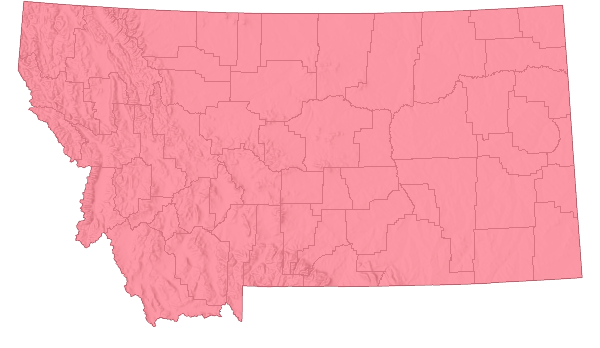
 Non-native
Non-native
Range Comments
David’s Spurge is native from southwestern USA and northern Mexico north to the central Great Plains, but is apparently adventive elsewhere (Berry et al. in FNA 2016).
David’s Spurge has been documented through most of the USA with Idaho, Wyoming, and South Dakota being the nearest locations to Montana (Berry et al. in FNA 2016). The native range is presumed to include most of Nebraska and a portion of South Dakota (Mayfield personal communication). It is hypothesized to have come into Montana from Wyoming either along the Interstate-90 corridor or railroad tracks (Hansen personal communication).
Observations in Montana Natural Heritage Program Database
Number of Observations: 22
(Click on the following maps and charts to see full sized version)
Map Help and Descriptions
Relative Density
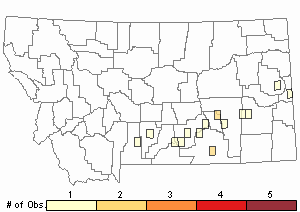
Recency
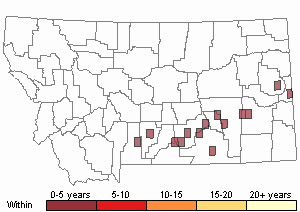
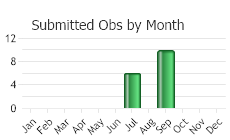
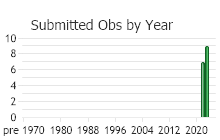
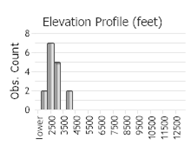 (Observations spanning multiple months or years are excluded from time charts)
(Observations spanning multiple months or years are excluded from time charts)
Habitat
In North America, David’s Spurge has been found in forests, stream and river banks, prairies, roadsides, and open disturbed areas (Berry et al. in FNA 2016). In Montana plants are establishing along roadsides at interstate exchanges and in city parks.
Ecology
David’s Spurge can vary greatly in size with plants growing larger in well-watered areas (Mayfield personal communication).
Reproductive Characteristics
Plants reproduce by seed.
FLOWER [Sources: Mayfield 1997; Berry et al. in FNA 2016]
Flowers have peduncles, 0.5-1.0mm long within a small, cup-like involucre (cyathium). Each cyathium bears 5-8 stamens (male flowers) that surround a single pistil (female flower). The pedicel of the pistillate flower elongates in fruit, to 3mm long. The pistil has a glabrous or sparsely strigose ovary and 3 styles that are partially united and splits into 1 mm long branches.
In the Cited Literature section consult Stein (2011) to learn about Euphorbia ‘flowers’, cyathia.
FRUIT [Sources: Mayfield 1997; Berry et al. in FNA 2016]
Fruit is a capsule. Capsule is ovoid, 2.9-3.3 x 4-4.8 mm, 3-lobed, glabrous. Columella is 2.2-2.7 mm long. Seeds are black to brown or pale gray, ovoid to triangular ovoid, angular in cross section, 2.4-2.9 x 2.2-2.9 mm. Surface of the seed has low tubercles that are irregularly arranged or occurring in faint, transverse rows. Seeds easily roll due to their shape. Caruncle 0.9-1.1 mm.
GENETICS
Chromosome number is 2n=56, making this plant species a tetraploid among the Euphorbia section Pointsettia species (X=14).
Management
The likely primary vector for long-distance dispersal is presumed to be as a contaminant in wheat seed (Mayfield personal communication). Humans definitively have aided its dispersal into Wyoming and Montana (Mayfield personal communication). David’s Spurge has become an agricultural weed where it has been introduced into places within North America, South America, Australia, and Russia (Berry et al. in FNA 2016), specifically into wheat-growing regions (Mayfield personal communication).
David’s Spruge does not compete well in established native grasslands unless vegetation is sparse (Mayfield personal communication).
Stewardship Responsibility
Threats or Limiting Factors
David’s Spurge has become an agricultural weed where it has been introduced into places within North America, South America, Australia, and Russia (Berry et al. in FNA 2016).
References
- Literature Cited AboveLegend:
 View Online Publication
View Online Publication Flora of North America Editorial Committee, eds. 2016. Flora of North America north of Mexico, Vol. 12. Magnoliophyta: Vitaceae to Garryaceae. Oxford University Press, Inc. New York.
Flora of North America Editorial Committee, eds. 2016. Flora of North America north of Mexico, Vol. 12. Magnoliophyta: Vitaceae to Garryaceae. Oxford University Press, Inc. New York. Hansen, Kurt, and Mark Mayfield. 2023. Electronic Mail Correspondence on the First Observation of Euphorbia davidii in Montana. January 11-27. Personal communication between Kurt Hansen, District Ranger, Sioux District, Custer Gallatin National Forest, Camp Crook, South Dakota and Mark Mayfield, Professor, Kansas State University, Manhatten, Kansas.
Hansen, Kurt, and Mark Mayfield. 2023. Electronic Mail Correspondence on the First Observation of Euphorbia davidii in Montana. January 11-27. Personal communication between Kurt Hansen, District Ranger, Sioux District, Custer Gallatin National Forest, Camp Crook, South Dakota and Mark Mayfield, Professor, Kansas State University, Manhatten, Kansas. Hansen, Kurt. 2023. Personal Communication of 2023 Euphorbia davidii observations. July 24th. District Ranger, Sioux Ranger District, Custer Gallatin National Forest, Camp Crook, South Dakota.
Hansen, Kurt. 2023. Personal Communication of 2023 Euphorbia davidii observations. July 24th. District Ranger, Sioux Ranger District, Custer Gallatin National Forest, Camp Crook, South Dakota. Hansen, Kurt. 2024. 2022-2023 Observations on David's Spurge (Euphorbia davidii Subils) in Montana. Updated January. Version 2. Sioux Ranger District, Custer-Gallatin National Forest, Camp Crook, South Dakota.
Hansen, Kurt. 2024. 2022-2023 Observations on David's Spurge (Euphorbia davidii Subils) in Montana. Updated January. Version 2. Sioux Ranger District, Custer-Gallatin National Forest, Camp Crook, South Dakota. Hitchcock, C.L. and A. Cronquist. 2018. Flora of the Pacific Northwest: An Illustrated Manual. Second Edition. Giblin, D.E., B.S. Legler, P.F. Zika, and R.G. Olmstead (eds). Seattle, WA: University of Washington Press in Association with Burke Museum of Natural History and Culture. 882 p.
Hitchcock, C.L. and A. Cronquist. 2018. Flora of the Pacific Northwest: An Illustrated Manual. Second Edition. Giblin, D.E., B.S. Legler, P.F. Zika, and R.G. Olmstead (eds). Seattle, WA: University of Washington Press in Association with Burke Museum of Natural History and Culture. 882 p. Mayfield, Mark. 1997. A systematic treatment of Euphorbia subgenus Poinsettia (Euphorbiaceae). August. Doctor of Philosophy Dissertation. University of Texas, Austin.
Mayfield, Mark. 1997. A systematic treatment of Euphorbia subgenus Poinsettia (Euphorbiaceae). August. Doctor of Philosophy Dissertation. University of Texas, Austin. Stein, G. 2011. Euphorbia 'flowers', an introduction to the amazing Cyathia. https://davesgarden.com/guides/articles/view/3208
Stein, G. 2011. Euphorbia 'flowers', an introduction to the amazing Cyathia. https://davesgarden.com/guides/articles/view/3208
- Additional ReferencesLegend:
 View Online Publication
View Online Publication
Do you know of a citation we're missing? Legler, Ben. 2021. RM Herbarium Specimen 1045133 of Euphorbia davidii. August 2nd. Rocky Mountain Herbarium Laramie, Wyoming.
Legler, Ben. 2021. RM Herbarium Specimen 1045133 of Euphorbia davidii. August 2nd. Rocky Mountain Herbarium Laramie, Wyoming. Missouri Plants. 2023. Photographs and descriptions of the vascular plants of Missouri, USA. Accessed 28 July 2023. http://missouriplants.com/
Missouri Plants. 2023. Photographs and descriptions of the vascular plants of Missouri, USA. Accessed 28 July 2023. http://missouriplants.com/
- Web Search Engines for Articles on "David's Spurge"





